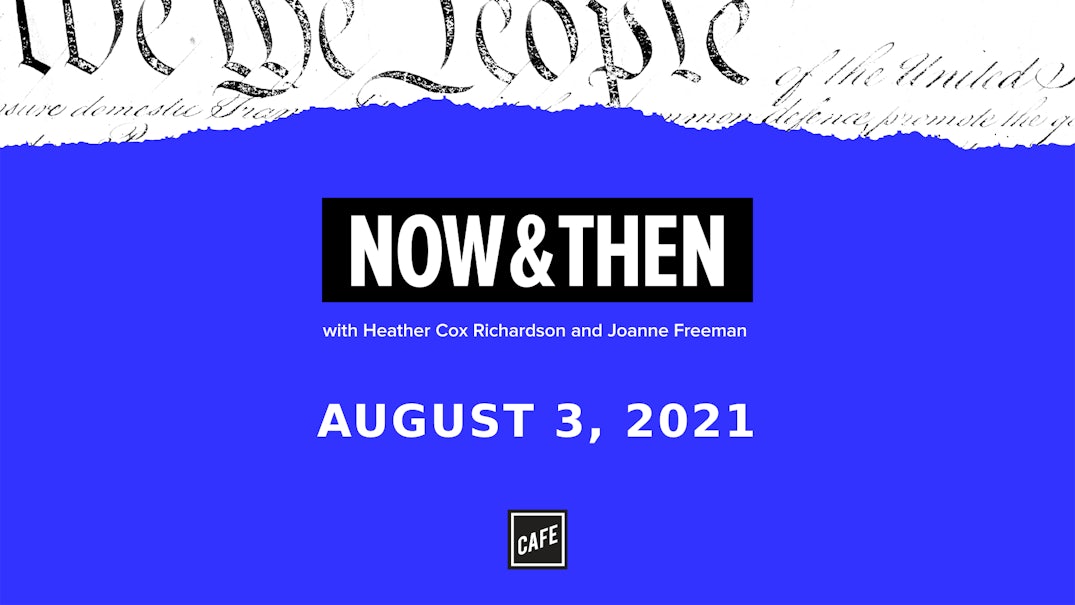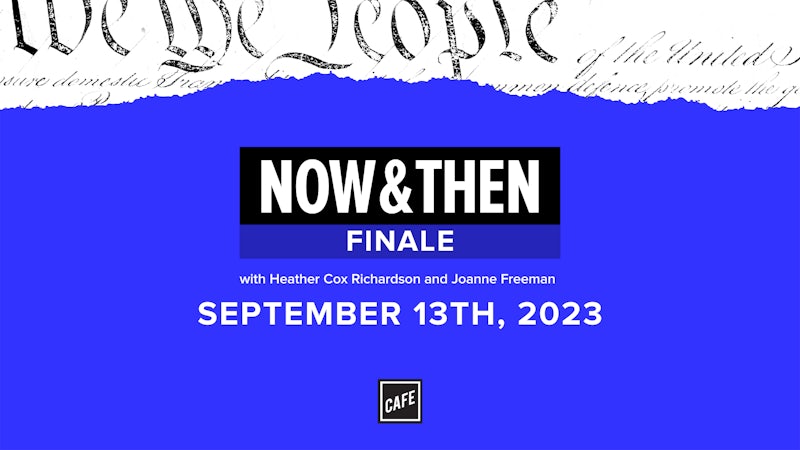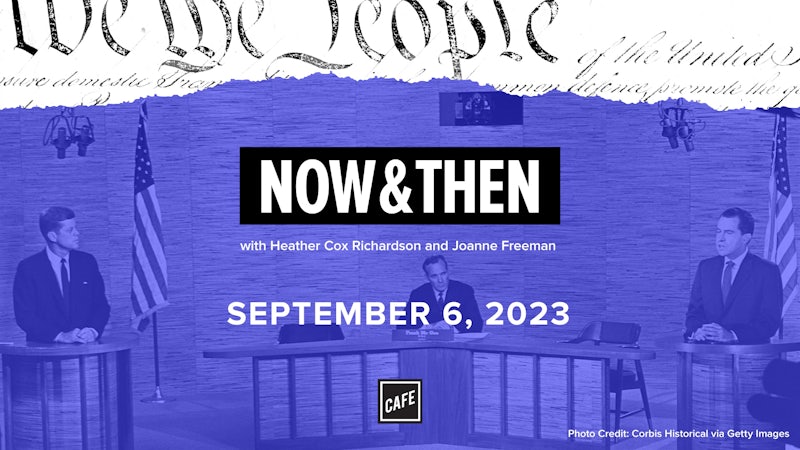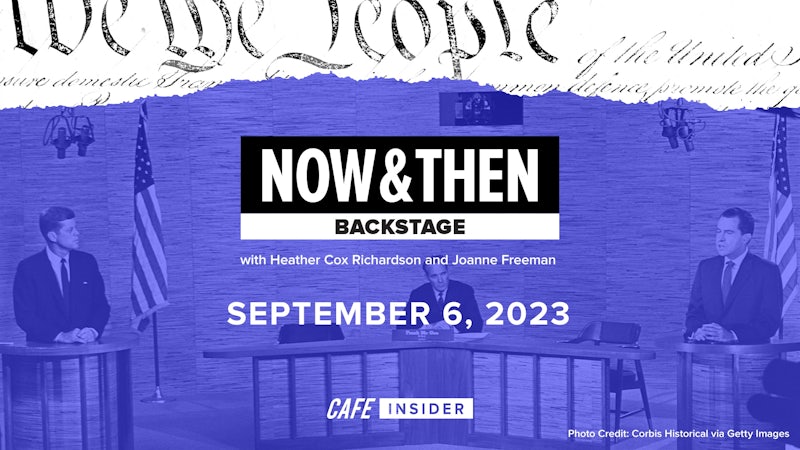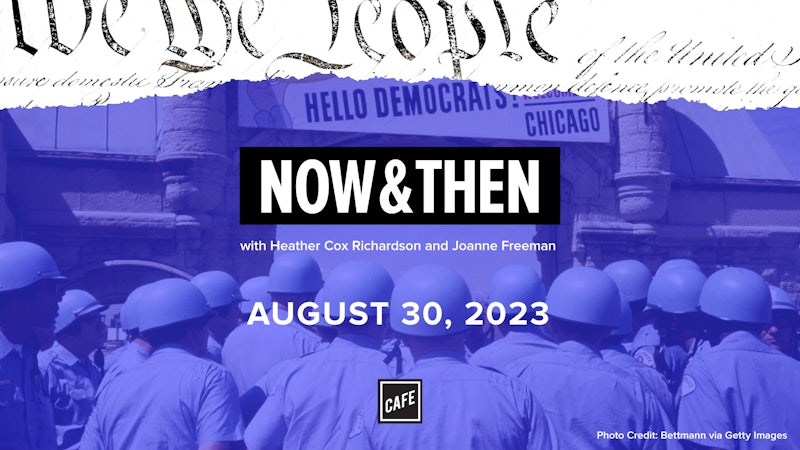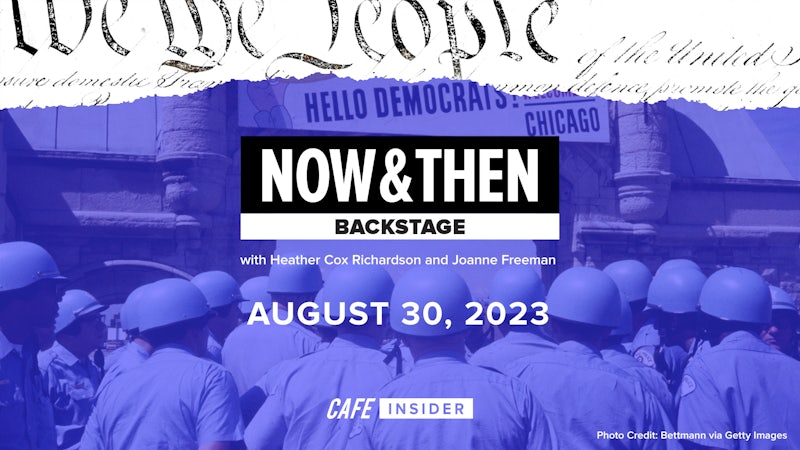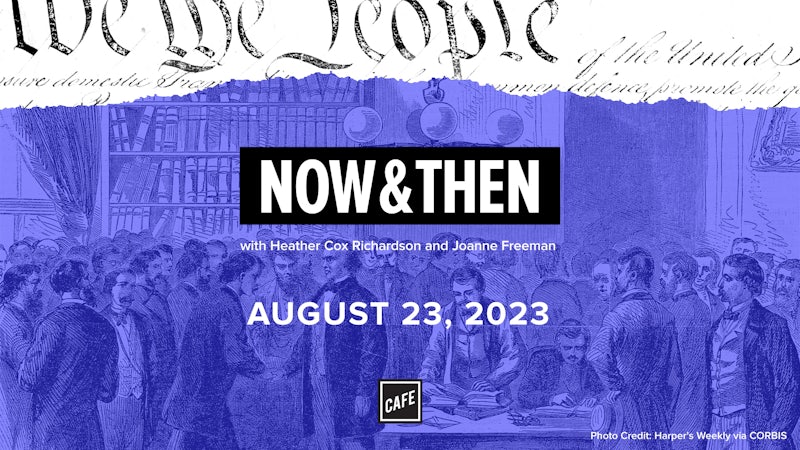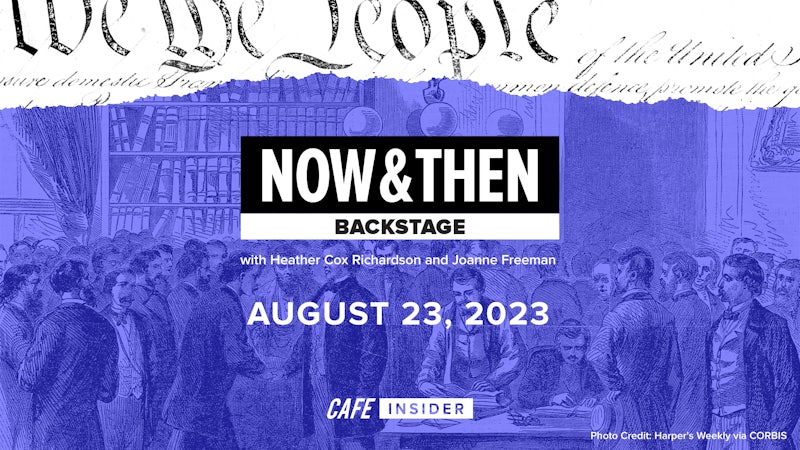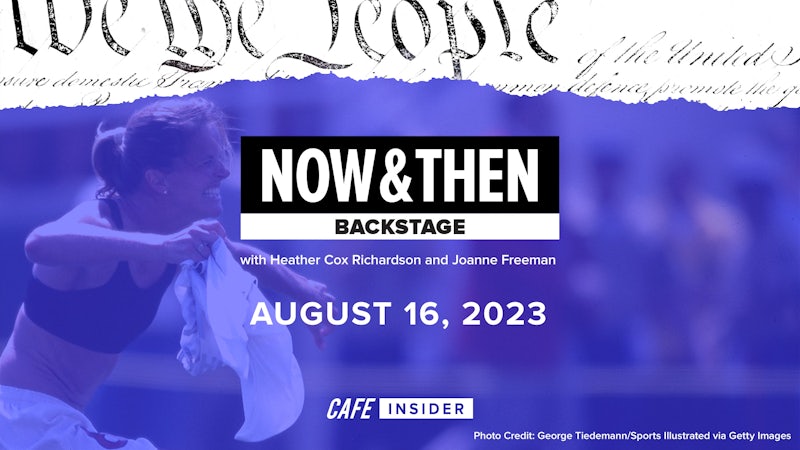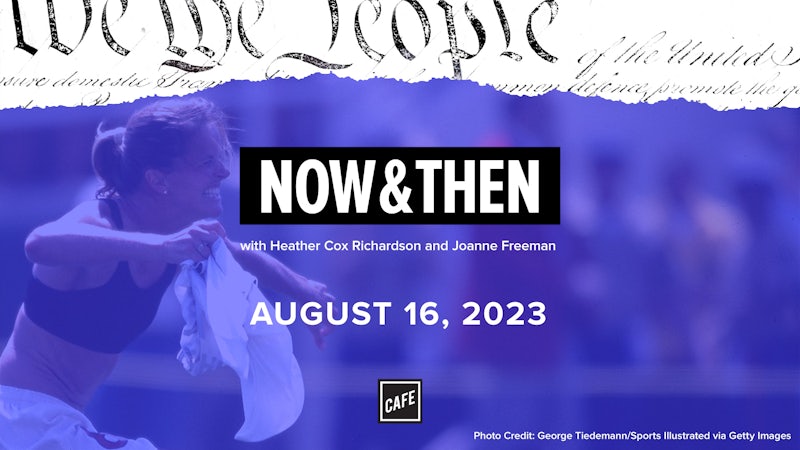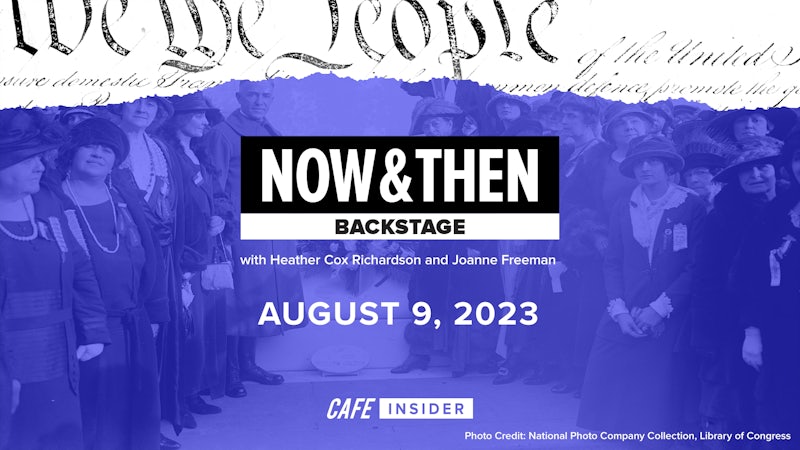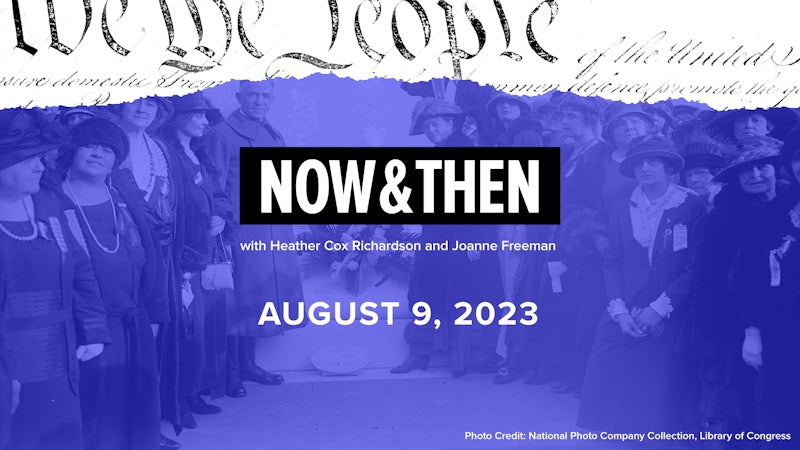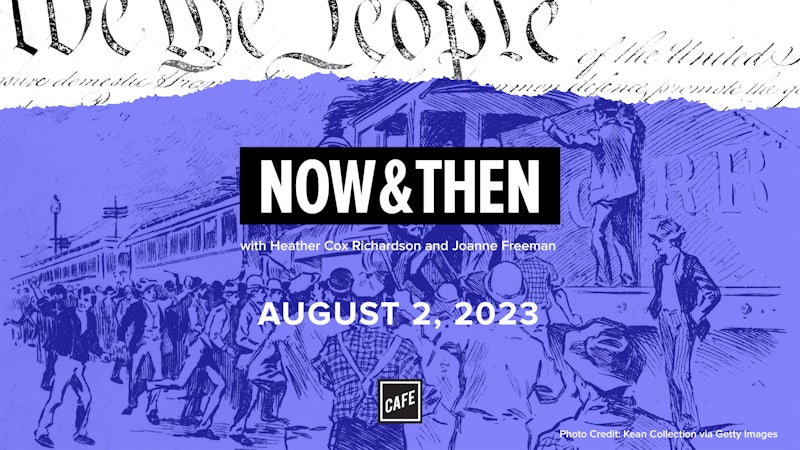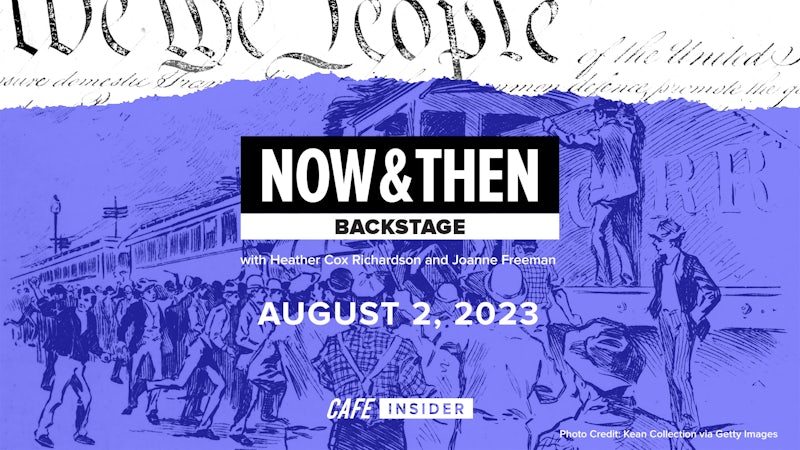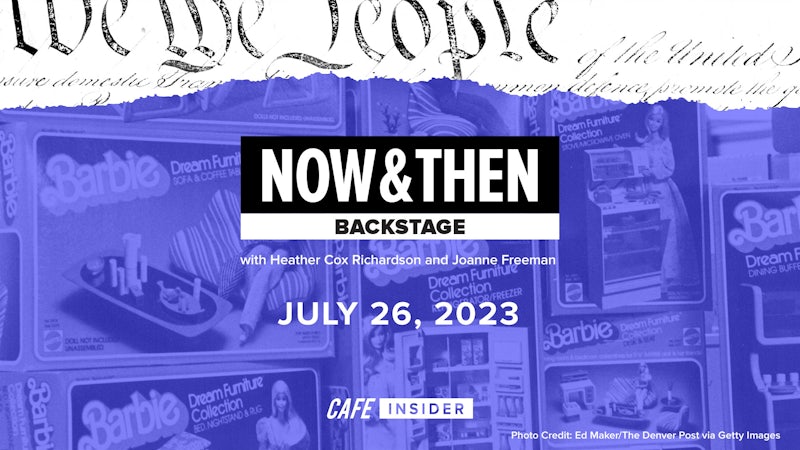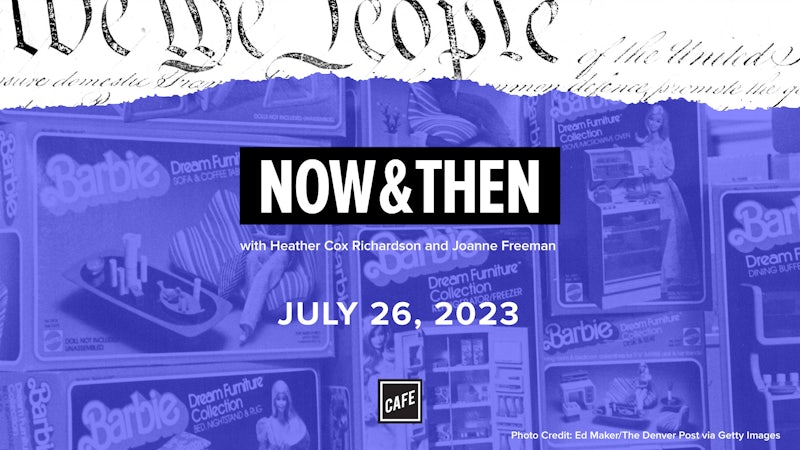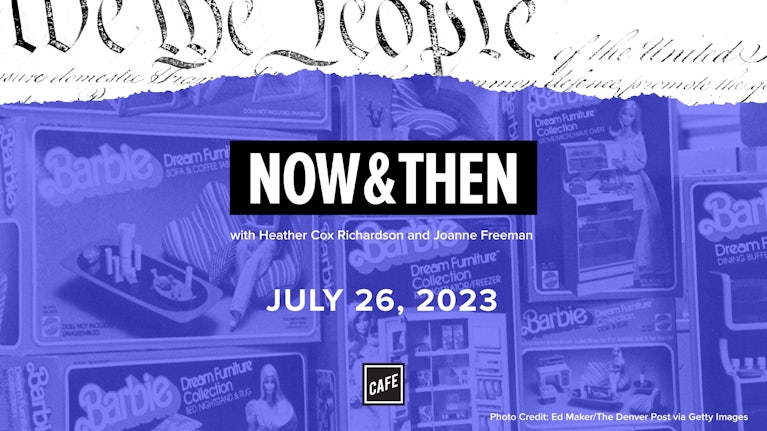Joanne Freeman:
From CAFE and the Vox Media Podcast Network, this is Now & Then. I’m Joanne Freeman.
Heather Cox Richardson:
And I’m Heather Cox Richardson.
Joanne Freeman:
And today, we want to talk about the subject, I suppose as always, related to something that’s in the news, but that has a long history attached to it and it has a lot to say about what the United States wants to be and what the United States is. And it’s branching off of the Olympics.
Obviously, we are in the midst of the Olympic games. There’s been a lot of discussion of the Olympic games, particularly because of Simone Biles and her decision to withdraw from the two main events of the Olympics. And there’s been a lot of really strong reaction to that.
So, what Heather and I are interested in exploring and speaking for you here, Heather, what we want to explore is what do things like the Olympics or like big displays, like world’s fairs. What is it that they’re saying about the United States? What is it that people want them to say? And what are they actually showing?
Heather Cox Richardson:
So, we talked about doing an episode on the Olympics. And I don’t think either one of us sent up skyrockets. We’re sort of like, we kind of as historians, we kind of know the stories. We know Jesse Owens in the 1930s. We know the in 1968 Black Power movement.
Joanne Freeman:
I don’t have the sports gene either. I am missing the sports gene.
Heather Cox Richardson:
We’ll just drop that one right there. But what we talked about was how the Olympics are important because they’re a way for people to define what America is and what it stands for. And then, of course, knowing Joanne and me, we went, “Oh, well, that’s just like how Americans did it in the 19th century and the 18th century.”
Joanne started us off with what I think is one of the best stories in early America. And that’s the idea of portraying the country, or this new American nation, to Europe, and how and why Benjamin Franklin becomes such a dramatic symbol of America.
Joanne Freeman:
It’s a great story partly because it’s such a straightforward story. Because if you think about where the United States was in the 1780s and even into the 1790s, the United States is a really new nation. It has no real reputation on the international stage. It’s trying to determine and project an identity of itself that’s going to serve itself, that’s going to help bolster it in the eyes of the world and also serve itself in other ways, including economically.
So, in this early period, people are really aggressively thinking about and projecting an image. And there are two people in particular that do this in a really interesting way. I’m sure there’s more. But the two I want to talk about are Benjamin Franklin and Thomas Jefferson.
Heather Cox Richardson:
But so, wait, is it fair to say that if you’re a European in this period, it’s not like you can hop on a plane or see photographs or have any real sense of what North America looks like. So, you’re really susceptible to whatever images are projected because that’s all you got. You got people talking about what America is and what it looks like. You have no sort of ability to fact check anything.
Joanne Freeman:
No, absolutely. It’s images, which can be pretty wild, and its visitors, people who went to North America and go back to Europe and have assumptions about what they saw, which I’m going to come back to because that actually plays a role in what some of the French thought about the United States or about North America has to do with who visited where.
But Franklin and Jefferson are both two people who were very involved in essentially foreign relations and going abroad to represent the United States. Franklin is sent during the revolution. He’s sent in 1776 to try and get French aid for the revolution, which was desperately needed. So, he’s sent with a commission. And before when he had gone to France, because he had been there before, he had dressed as a French gentleman.
He writes to a friend actually a female friend, and says that basically in six days in France, well, I’ll quote him here, “My tailor and perruquier had transformed me into a Frenchman. Only think what a figure I make in a little bag-wig and with naked ears. They told me I was become twenty years younger, and looked very gallant.” So, he’s made into a Frenchman. But now 1776, he goes back and something is very different. He dresses himself deliberately very different to send a message, as he says later in a letter actually to another woman friend.
Heather Cox Richardson:
I was going to say how you’re just sort of slipping those in there.
Joanne Freeman:
I know. Well, I just noticed it for the first time. He dresses in very plain clothes, which I suppose would have been typical of a Quaker in the period. He just has his own hair down and straight. And he’s wearing a very prominent fur hat, which I’ll bet a lot of people listening have probably in one way or another seen that image because it becomes so famous.
And Franklin wrote, “Think how this must appear among the powdered heads of Paris. I wish every gentleman and lady in France would only be so obliging as to follow my fashion, comb their own heads as I do mine, dismiss their friseurs,” their, again, a kind of hairdresser, “and pay me half the money they pay to them.” So, he comes there as this sort of plain-dressed person, no frill to his hair and his big fur cap on his head. And the French, obviously, noticed it. It’s meant to be noticed.
And they say things like the contrast between as one noble onlooker in France puts it, “The contrast between the luxury of our capital, the elegance of our fashions, the magnificence of Versailles, the still brilliant remains of the monarchical pride of Louis XIV, and the almost rustic apparel, the unpowdered hair, the plain but firm demeanor, the free and direct language of the envoys.”
And what’s interesting here, and this is the point, larger point I want to make, he says that simple costume seemed to have introduced within our walls of the luxurious France, “in the midst of the effeminate and servile refinement of the 18th century, sages contemporary with Plato, or republicans of the age of Cato and of Fabius.”
So, already someone’s like, huh, this is something not us. And it’s maybe harkening back to something that has some values, some merit. So, basically, Franklin is trying to promote to Europe an image, which one observer, luckily for historians, actually very explicitly puts into writing.
A French observer says, everything on Franklin announced the simplicity and innocence of primitive morals. Franklin had laid aside the wig, which formerly in England, hid the nudity of his forehead and the useless adornment that would have left him at the level of other English. So, innocence, simplicity, and he’s not English. It’s a really, really powerful message that people get. And he becomes wildly popular and his image appears everywhere because it becomes a kind of cultural phenomenon.
Heather Cox Richardson:
Washington is running around at the same time, going, “Oh, if I have this color button, I’m representing this…”
Joanne Freeman:
Oh, Washington is doing the same thing in his inauguration. I shall wear a plain brown homespun suit and then I will show people I am not a king. So, even among the American people, the same thing is happening. But it’s not just Franklin. And obviously it’s Washington, too. But it’s also Jefferson, who a little later, 1785 through 1789, becomes a foreign minister to France for the United States. And he is very engaged in this sort of ongoing scientific discussion, but maybe it’s more of a feud, that’s led by George Leclerc, the Count de Buffon, who is a leading French naturalist.
Now in a 1770s volume of Buffon’s enormous 44 volume, natural history, titled Natural History, General and Particular, Buffon argues that American animals degenerated in size compared with those of Europe because of the climate and vegetation of North America. So, he describes North American animal life as shriveled and diminished because the weather is colder and also because it’s more humid.
Now, if you think about colder and more humid, and then think about where the French were probably visiting at this time period, because Buffon had never been to North America, French visitors often went to Canada, which was very cold, and which had to do with fur trapping, or they went to Louisiana, which was owned by the French and was very humid. So, probably in France, people come back and say it’s really cold or it’s really humid and there you go, right what Heather said a little while back. That’s what people know about the United States.
But so, there’s real anger, there’s outrage, there’s pride. There’s a lot invested in this idea that somehow the new world is inferior, is degenerate in relation to the old world. And some of that has to do with national private identity. Some of that has to do with economics, has to do with them wanting people to come to the United States, to invest in the United States. Degenerate is not going to help that happen at all.
It even appears in the Federalist essays. Hamilton says in the Federalist that there are these “profound philosophers in Europe,” who have arrogant pretensions that the new world is degenerate. And that it belongs to us to vindicate the honor of the human race and to teach that assuming brother, meaning Europe, moderation. So, it’s personal, it’s political, it’s national, it’s economic. There’s a lot invested in this.
So, Jefferson decides to take on the degenerate idea in Notes on the State of Virginia, which is the only book that he wrote in the course of his life, which he writes in 1785. He very aggressively talks about this by showing and comparing the measurements and sizes of animals in Europe and in the United States. And when I assign that book in my classes, I always tell my students, you do not have to read all of the numbers because you’re not going to want to and it’s going to be not very exciting. And sure enough, Jefferson himself knew that that wasn’t the strongest way to make his point, that nothing was degenerate in the United States.
So, he decides he’s going to get animal bones and hides to Paris, have them sent to Paris, to show the French and particularly to show Buffon that, “Oh, no, there are not degenerate animals here. They are larger than European animals.”
Heather Cox Richardson:
So, many people were noticing at the time that the North American continent did not appear to have the same kind of giant animals, for example, that other parts of the world did. So, we don’t have in that period elephants, for example, or any of the really large mammals.
So, for example, we start to call our bison, which scientific name is bison, bison. We call it a buffalo. It’s not a buffalo, but they’re looking at water buffaloes and going well really, if you squint real hard, this could be as big as a water buffalo…
Joanne Freeman:
Jefferson goes even further and he assumes that there are woolly mammoths roaming around even now in the west. And those are, wow, that’s a big animal. It’s why he’s called the mammoth president and people send him a mammoth’s cheese has part to do with his investment in woolly mammoths.
Heather Cox Richardson:
Okay. So, I have never heard him called the mammoth president. I do believe I’ve heard of the mammoth cheese, although I feel like that deserves its own episode.
Joanne Freeman:
Right.
Heather Cox Richardson:
But can you walk us through his attempt to prove that America really does have giant animals?
Joanne Freeman:
So, he writes to friends. He has them send things and he’s very invested in having someone send him a moose. Those are huge animals.
Heather Cox Richardson:
Yeah. I was going to say, like, when you say that, he has people send him stuff, and in my world, that’s, “Hey, could you send me a book?” This is, “Could you send me a moose? Sens me a moose.”
Joanne Freeman:
And he says if you could send it here, these are his words, it would be more precious than you can imagine. Could I choose the manner of preparing them, it should be to leave the hoof on, to leave the bones of the legs and the thighs, if possible, in the skin, to leave also the bones of the head in the skin with the horns on, so that by sewing up the neck and belly of the skin, we should have the true form and size of the animal. That’s very Jeffersonian that the sort of detail about this what he wants sent.
Heather Cox Richardson:
About preserving a moose.
Joanne Freeman:
The size, preserving the moose and preserving its size, really important. And 15 months later, he actually gets a moose. And he’s very happy about it. And he does indeed show it to Buffon and he insists that Buffon now agrees that animals in the United States are not smaller. Buffon dies before he can say anything about that.
But to me, the best part of the story is, he gets the moose. But then, he’s very upset because the horns aren’t big enough. They’re not impressive enough. And he begins writing back to his poor friends in the United States saying, “Get bigger horns.” He’s saying to the French, “Those aren’t typical horns. Those are smaller horns.”
Now, the whole point of all of these wonderful stories is here’s this new United States, trying to send a message that the new world is better and pure and more virtuous because it’s less decadent, that it’s certainly not inferior and possibly superior to Europe. It’s bigger and better, and for political and national and economic implications, that can have huge stakes.
Heather Cox Richardson:
So, by the 19th century, this whole idea of different countries comparing each other and trying to prove that they’re the best takes on the form of world’s fairs or expositions is what they’re called in the middle of the 19th century.
And that really gets launched from London in 1851 with the Crystal Palace at the London Great Exhibition of the Works of Industry of All Nations. And visitors go to the Crystal Palace and are just awed by all the displays of how wonderful, for example, the British textile industry is.
So, Americans start to look at this and think, “Well we could do the same thing.” And in 1853, New York constructs its own Crystal Palace. It’s 152,000 square feet, and tries to have its own smaller version of the London Crystal Palace. But this idea takes off. Americans start to think that they should be showcasing who they are as well.
So, in 1876, with the Centennial Exposition in Philadelphia, America starts to display for example, telephones and steam engines, and all the different ways that American industry is theoretically moving the human ball forward, if you will.
But this really becomes the American showcase in 1893 with the Columbian Exposition. And I always loved the date of the Columbian Exposition, which is 1893, because they were aiming for 1892 with the anniversary of Columbus’s arrival in America. But in a way that is after my own heart, they missed it by a year. But the Columbian Exposition becomes a really big deal for America to showcase what it means to be an American.
So, first of all, there’s a big fight over where it’s going to be held, and Chicago wins. And Chicago wins in a really important move for the country. Because what they’re trying to do by putting the exposition in Chicago is to demonstrate that this raw frontier, if you will, Chicago, which is known for its slaughterhouses at the time, and the fact it’s a railroad hub, in fact, has cultural attributes, really exciting cultural attributes.
So, they’re essentially saying America’s got this giant country. We’ve got this incredibly powerful economy. We’re industrializing really quickly, but a whole look, we also have cultures. So, for example, Frank Lloyd Wright, who’s just beginning his architectural career makes some of the arches, some of the gates for people going into the entrance. And there’s a great emphasis on art and on jewelry. Tiffany has a major exhibit at the Columbian Exposition.
But what the exposition does is it tries to highlight what America is contributing to the world. So, for example, the centerpiece of the fair was the Hall of Manufacturers & Liberal Arts, and it was more than 1600 feet long, it was almost 800 feet wide, it was 236 feet high. It covered more than 40 acres, which was enough space to build 500 homes inside.
Joanne Freeman:
Think about the size of this. I mean, I think it’s easy to overlook that. They build a city. It’s called the White City, because of all these big white buildings. I mean, it’s pretty remarkable. And so, I give them permission to be a year late, basically.
Heather Cox Richardson:
Well, and that’s going to be an interesting story when it all comes down. But within this is a cotton exhibit, which shows how much cotton the country is producing more than 3.6 billion pounds. It’s showing all the things that workers are producing in this new century. Ready-made clothing, for example, that claims to be worth, an industry worth more than $300 million that are paying more than $70 million in wages.
But then the exhibits go on to show American manufacturer wire. So, of course by 1873, Americans are manufacturing barbed wire in huge numbers in huge amounts, guns, for example, new chemicals, new ceramics. We get typewriters exhibited here with their ribbons that are made of girls’ hair ribbons dipped in ink.
Joanne Freeman:
Even just electricity. I mean-
Heather Cox Richardson:
Which lights it all up.
Joanne Freeman:
… for many people, it was the first time for some people that they saw electricity in action. So, even everything surrounding this amazing building shows something remarkable about the present and suggests a remarkable future.
Heather Cox Richardson:
And my favorite exhibit in this whole way of showcasing American power and new industry is the fact that they have a large exhibit of artificial limbs. Because after the Civil War, America becomes one of the world leaders in prosthetics, because so many men lost arms and legs and eyes as well during the war. And Americans don’t think about that and don’t think about the fact that really weirdly, the Civil War becomes instrumental in making America vault at the time to the front of making prosthetic limbs.
Joanne Freeman:
There are 48 nations represented there. But between May 1st and October 30th, the opening to the closing, 27 million people visited, a quarter of the entire American population visited the fair. So, the message is that Heather just talked about and that we’re about to talk about that message is going to a lot of people.
Heather Cox Richardson:
Well, and one of the things that really that I love also about this fair is that in 1889 in France, when France had done a world’s fair, the entrance to the fair was actually the Eiffel Tower. That’s where the Eiffel Tower comes from. That’s 1889.
And then five years later, America basically says, “Hey, we can build a big metal structure, but we can make it move.” And that’s where we get the Ferris wheel. And the Ferris wheel built by George Washington Ferris, which is again, a moving structure made out of steel. If you think about what that means in 1893 and for the months that the fair was an operation, that means that for most Americans for the first time, they can literally leave the ground.
Because until then, if you lived in, I don’t know Nebraska, you could climb a tree, but otherwise, you were always going to be sitting at ground level or you’re on a hill or whatever, but you weren’t going to be able to have that new perspective on the world. You could literally pay some money and go up in the air and see the world in an entirely different way as if you were a bird.
And this idea of the mechanics and the invention of Americans enabling you literally to go into the skies, especially at a time when the fair opens just as the crash of 1893 is rippling out across the country, suggests that American ingenuity can overcome anything and that everybody is going to be able to be upwardly mobile in American society, literally, upwardly mobile in American society.
One of the reasons we all study the Columbian Exposition to the degree we do is because it’s a central question about race, essentially, and how race and gender is going to fit into this upwardly mobile vision of American society. So, there is a big argument about whether or not women should be held separate, they end up having a different building at the fair.
And actually, one of my great lost moments in American history is that Mary Cassatt actually paints a mural in that building. And when the fair, we’ll talk about what happens to the fair, when the fair ends, that mural is lost. We have really not very good representations of what that mural look like. But the question is, do women participate in the fair in general? Do they exhibit in the main hall or should they be held separate?
Much more famous, of course, is that the same argument happens in the black community. Should African Americans have their own parts of the fair or should they participate in the exhibit buildings that are constructed by white Americans?
Joanne Freeman:
There’s the same kind of conversation about black Americans and about women, where should they be in the fair. Except in the case of black Americans, it’s also should they be in the fair. For women, it’s what kind of pavilion should there be for women. What should it be representing? For black Americans, the question is, should they have a pavilion at all. And the answer, as far as the United States is concerned, is no.
Heather Cox Richardson:
Well, but within that fight, and Ida B. Wells writes a very famous pamphlet saying we shouldn’t be participating in this unless we are funded separately and participate on our own terms. There’s also a fight though within the black community saying, “Wait a minute, we don’t want to be separate. We want to be included in the definition of what it means to be an American.”
So, for example, George Washington Carver, who’s a very famous American botanist, exhibits in the main pavilion. Booker T. Washington, the famous philanthropist and educator gives lectures in the main pavilion.
So, there is within the American discussion at the time, who is welcome. But then within the black community, there’s this division, how do African Americans participate in the version of America that is being presented in this exposition.
Joanne Freeman:
And here’s how some of the black community answers that. And basically, they use the Haitian pavilion to speak out on their own behalf to say what they want to say. One place in the fair where there was an official black presence, and as, Heather, you just mentioned, Ida B. Wells, is there, makes appearances there. Frederick Douglass makes appearances there. He had once been an American minister to Haiti. It’s built by the government of Haiti, but its message goes beyond Haiti. Although Haiti as the only country that liberated itself from slavery and remained free at this time, for many, embodied black progress. So, the message already is huge.
But the quote that I need to read only because it’ll kick you in the stomach with the power of it comes from Ida B. Wells. I really love Ida B. Wells, she’s kind of a hero of mine. She writes, “Haiti’s building was one of the gems of the World’s Fair, and in it Mr. Douglass held high court. The peculiar thing about it was that nearly all day long it was crowded with American white people who came to pay their respects to this black man whom his own country had refused to honor.”
That’s a kick you in the guts kind of a quote that really is making that message about what is being represented here, what isn’t being represented here, what’s being shown as being included in the United States, and what’s being shown to be excluded, and how are these people who are supposedly excluded finding their own way to make a strong statement.
Heather Cox Richardson:
And so, perhaps some of the explanation for this or some of the way that Americans tried to grapple with this disparity in the main part of the fair was out in the fairgrounds where Buffalo Bill had one of his largest shows ever.
And Buffalo Bill’s Wild West show, which was the big entertainment of the late 19th century, and it was very much a constructed image, presented an image of individual white men who were fighting against what at the time they would have called savagery, not necessarily only the indigenous people with whom the characters in Buffalo Bill’s Wild West show did skits, but also the other people who lived in the west.
And in Buffalo Bill’s Wild West show, and people would go to see the exposition. And then they would of course, go see Buffalo Bill’s Wild West show. And one of the things that they do is the line up indigenous Americans from their original tribal existence, if you will, and show them becoming what at the time Americans would call civilized.
They literally go in these buildings from being tribal representations as if the people are coming directly from in this case, the American plains, and then show them getting American educations, putting on suits, cutting their hair, and there’s actually exhibited, exhibited, that word is very important, an Apache young man who is related to Cochise and Geronimo, and they very proudly say that he is going to finish his education at Harvard.
So, there is this idea that America is literally transforming individuals from what they would consider one of the lowest planes at this time before we get the concept of culture as being anything other than high culture and not until the early 20th century going to get the idea of culture simply being the folkways for people, the idea that America literally gives people an opportunity to go from this what they consider a low standard to graduate from Harvard.
Joanne Freeman:
Again, this is the second time I’m saying, it’s a punch you in the gut kind of obvious statement. Another one, they had at the fair what they called living villages, which were supposed to be these ethnological villages that were showing representatively people from different societies around the world.
So, a lot of them were African and Asian, again, partly playing on the “exoticism” of it, but there were Egyptians, there were Eskimos, there were Chinese and Irish and German and Austrian people, which in and of itself is interesting. However, the way that each village was ordered is that they were put in a line that led to ahead of you was the center of the fair, the White City. And I’m going to emphasize white.
And what they did with the individual villages was a sort of hierarchy in which they started out for this from the White City, where Native American villages was an African village, it’s sort of moved “up” to Austria to Germany. So, on the grounds as you walked through the exhibit of these villages, again, as what you just described, Heather, you’re literally walking through what the people who created the fair are constructing as the “progress of civilization.”
Heather Cox Richardson:
And people brought this home. I mean, you’re saying this Joanne, and one of the reasons I always wax enthusiastic about the Columbian Exposition is because it’s such a snapshot of America in that era. And it’s an era when we’ve got Congress has just decided it’s not going to protect the right of black men to vote in 1889 and 1890. So, this is right after that. The economy is collapsing. In 1890, you’re going to get the American Women’s Suffrage Association. And the National American Women’s Suffrage Association coming together to create a new American Suffrage Association.
Joanne Freeman:
There’s labor unrest.
Heather Cox Richardson:
There’s incredible labor unrest, and it’s all right there. It’s all right there, and it’s lit up with electricity. Let’s finish with this by what happens to the Columbian Exposition, which is one of my favorite stories.
Okay, we have this great economic crash, the crash of 1893. Things are terrible in the country. And now all of a sudden, the organizers of the exposition have this giant campus that is largely not useful once the exposition is over. And I again am going to put this in the passive voice, it burns.
Well, what happens is the newspapers and the people who were behind the exposition blame the burning on labor organizers. They say that it’s workers who burned the White City. Well, as a historian, I don’t know, I wasn’t there. And this is not really my area where I would study something like this, but you’re in a depression, you’ve got all these buildings that have no use and they happened to burn. It sure sounds like-
Joanne Freeman:
Happened to be burned by people who you really would like to be the ones who burn it for political purposes.
Heather Cox Richardson:
Yeah. But it just sounds to me like so many of the things that burned in the first half of the 20th century, it’s a little bit before that, it was an insurance fire. That’s at least how I’ve always understood it. But they were able even to use that destruction as a way to reinforce the idea that America is upwardly mobile, except for those dangerous black people, indigenous people, women and labor organizers. So, it’s really this perfect snapshot of America.
Joanne Freeman:
I mean, this is wonderful. Because even in the destruction of the fair, it’s representative, blaming labor unions. It’s like fair is going down and we’re still going to reflect one of the major conflicts that is in the United States at the time. So, it’s reflecting America and projecting America at the same time in all kinds of really powerful ways.
Heather Cox Richardson:
And now, we’re going to get to the 1936 Olympics, which is only 43 years after the Columbian Exposition. Jesse Owens, most of us know the story of Jesse Owens in Berlin. Jesse Owens was 23 years old in 1936 at the Olympic Games in Berlin.
He was the son of a sharecropper and he was from Alabama. He had gone to Ohio State where he was a track star. And I have to say, if you have seen clips of Jesse Owens, it’s pretty freakin amazing. The year before the Olympics, he had broken or tied four track and field world records in 45 minutes, which is about the amount of time it takes me to finish my coffee in the morning. He has broken four world records in 45 minutes. Sports historians know that performance as the day of days, just kind of astonishing.
Joanne Freeman:
It’s kind of biblical.
Heather Cox Richardson:
Yeah, yeah. And 23 years old, that’s another story. So, he becomes really the top of the track world. And he becomes one of the 18 black athletes that goes on the US Olympic team to Berlin in 1936.
While of course, in Berlin in 1936, there’s a lot going on both at the world level, but also with this very idea that the Columbian Exposition in 1893 had embraced, set up and propagated the idea that there are racial hierarchies in the world with a certain group of people on top.
Joanne Freeman:
So, Owens goes to those Olympics. They are controversial Olympic games because they’re taking place in Berlin, because of the fact that Hitler is on the rise. There’s a boycott of some against the Olympics, actually, America’s Amateur Athletic Union votes not to have a boycott. A lot of other people in countries, particularly countries with a large black population, [inaudible 00:32:41] has very strong feelings about this, vote to boycott four reasons of race. First, Owens supports the boycott, then he doesn’t and he decides to go.
And ultimately, not surprisingly, given his amazing skill, he won four gold medals for the United State. There were 11 gold medals overall for the United States. Six of them went to black Americans, four of them to Jesse Owens all by himself.
Heather Cox Richardson:
For the record here, I want to point out, it was the 100 meters, the long jump, the 200 meters and the 4×100 meter relay. And the clips are just, I mean, I’m speechless here.
Joanne Freeman:
But in this larger story, we’re telling, Heather, about Olympics and fairs projecting, as well as reflecting the United States. Here we have a big conflict over how the United States should relate with the games that have questions of hierarchy and race.
We have one individual in Jesse Owens, who obviously should be there, who’s remarkably skilled. But he himself initially is conflicted about whether he should be there or not, which again, really represents that moment, even though also America clearly is proud of him. He gets a parade in New York City when he returns. He is sending a message that Americans would love to send about the skill and the talent that exists in the United States.
However, I have to also reflect the reality factor, again, not only just in who’s represented and how they perform at the Olympics and what that suggests about the United States, but the legacy of the Olympics. Basically, Owens does not have a legacy. He celebrated in the moment and has this big parade and he’s famous and he very rapidly loses his prominence has problems basically keeping himself going or earning a living.
And later, he ends up being hired to race cars, and t rucks, and dogs, basically, to show off his speed. But again, as we talked about before, in a sense, being exhibited, and he himself said, “Those races made me sick. I felt like a freak.” So, he on the one hand is celebrated and so representative, and then on the other hand is cast aside as a black man in America and then so in some other ways is representative.
Heather Cox Richardson:
So, Owens stands for a different kind of America than Tommie Smith and John Carlos are going to represent in 1968, when they very famously stand on the podium at the Olympics after winning the gold and the bronze in the 200 meter.
Joanne Freeman:
With the Star Spangled Banner playing.
Heather Cox Richardson:
And raised their fists covered with black gloves to protest conditions of black Americans and black people in the world in the current setting of the 1960s. So, the story behind that comes out of the growing awareness of Americans in general, but especially black Americans of the discriminatory conditions in America and in the world in the 1960s.
And in 1967, a group of sprinters, who had been part of this incredible team at San Jose State University, began to talk about boycotting the 1968 Olympics because of the discriminatory policies of the Olympics and the conditions of black people at the time.
And they team up in ’67 with Lew Alcindor, a basketball star at UCLA at the time, most people now know him as Kareem Abdul-Jabbar, and I just got to throw in here, for all that he’s a phenomenal basketball player, he was a phenomenal basketball player. He’s the first one I really got into. He’s also a great writer. So, if you’re not following him, you should follow him. I read everything he writes. They decide to organize their activism into the Olympic Project for Human Rights known as OPHR.
Joanne Freeman:
And what’s fascinating is, first of all, they organize which is great, but they come up with formal demands, which show you both what the Olympics was like at this moment and also how they’re feeling about it.
They asked that South Africa and Rhodesia be disinvited from the games because of apartheid. They asked for the restoration of Muhammad Ali’s heavyweight boxing title, which he lost for resisting the Vietnam draft. They asked for the resignation of International Olympic Committee Chairman Avery Brundage, who basically refuses to sanction racist nations at the Olympics. And he’s done that for quite some time. They asked for the hiring of more black assistant coaches. And they asked for a boycott of the New York Athletic Club, which engaged in discriminatory membership practices.
Heather Cox Richardson:
And Tommie Smith is they start to talk about the issues, the racial issues surrounding athletics, people, of course, who object to them talking about political issues come down very hard on them. And Tommie Smith, at one point says…
Tommie Smith (archival):
Many people have told me, “Okay, Smith, since you’re great now and you open your big mouth, you know that athletic couldn’t be on a political ballot.”
Heather Cox Richardson:
Which is really interesting, because of course, everything we’ve talked about is about politics. It’s about how America is represented. So, somehow now, we’re getting the transformation to you, an athlete, should not be part of this political discussion. You are, in fact, only a symbol, and a symbol of a certain kind of America.
Joanne Freeman:
Which is interesting and problematic logic in a lot of ways. But the statement is, you should not be political. You should not express political opinions. You should be a symbol. Basically, what that saying is you don’t have a voice. You’re supposed to stand there and be a symbol and not say anything. And it’s not as though I’m not saying anything, you’re not political, you are. You’re just being roped into one particular narrative and prevented from expressing another.
Heather Cox Richardson:
Well, it’s also really interesting because ’68 is, of course, exactly when Richard Nixon is really pushing the idea of American individualism. The idea that we don’t, in fact, need a government that levels the playing field amongst all Americans. But instead, everybody should stand on their own two feet.
So, you think about that and you think about the rise in the Olympics since the 1960s of this idea of individuals and their individual stories, and we have all these exciting tales of people who’ve made it from nowhere. And this is a great symbol of how individuals can make it in America. You’re all supposed to do those things, but on our terms.
So, the men who were competing in the 200 meters decided to go ahead and make a visible protest during the medal ceremony. So, they were patches from the OPHR, and they put them on their uniforms before the Star Spangled Banner starts. And Smith and Carlos mounted the podium without shoes on to symbolize black poverty where and they were wearing black socks. Smith wore a black scarf around his neck. Carlos left his tracksuit open to suggest that he was in solidarity with blue collar workers.
And during the playing of the anthem, they bowed their heads and each raised a gloved fist in a black glove into the air. It was Smith’s right hand. Carlos is left to symbolize an arc. Speaking of people like Jefferson or Franklin deliberately constructing their appearance. They literally were saying, well, we make an arc and we’re wearing the black socks.
Joanne Freeman:
I mean, that’s the thing. Think about the, I don’t know, the intricacy and the thoughtfulness of that message. So, yeah, when they stepped down, they get booed by the crowd. And equally interesting, particularly relating to the present, which we’re going to swing back to in a few moments, some of the press claim that these athletes embarrassed the United States.
So, for example, Brent Musburger, who’s reporting for the Chicago American says, “One gets a little tired of having the United States run down by athletes who are enjoying themselves at the expense of their country. Protesting and working constructively against racism in the United States is one thing. But airing one’s dirty clothing before the entire world during a fun and games tournament was no more than juvenile gesture by a couple of athletes who should have known better.” And Brundage, Avery Brundage of the Olympic says, “I think you will agree it was a disgrace to the United States.”
Heather Cox Richardson:
And he throws them out of the Olympic Village.
Joanne Freeman:
Correct.
Heather Cox Richardson:
So, interestingly enough, Time Magazine also jumps on these two men saying, “Faster, higher, stronger is the motto of the Olympic Games. Angrier, nastier, uglier better describes the scene in Mexico City last week. Sprinters Tommie Smith and John Carlos, two disaffected black athletes from the US, put on a public display of petulance that sparked one of the most unpleasant controversies in Olympic history and turn the high drama of the games into the theater of the absurd.”
And I mentioned that because just two years later, Time Magazine is going to put on its cover as the people of the year, middle class Americans who are tired of things like they saw at the Olympics in 1968. For his part, though, Smith says.
Tommie Smith (archival):
I can say I represented Black America. I’m very proud to be a Black man and also to have won a gold medal. And this I thought, I could represent my people by letting them know that I’m proud to be a Black man.
Joanne Freeman:
So, we just talked about the Olympics. We talked about athletes making political statements. We talked about people booing them for doing so and saying they shouldn’t have political messages and that they are embarrassing the country, which brings us back to the present and Simone Biles.
So, here she is. She is having problems with her performance. I had not heard of the twisties before the news coverage of this withdrawal, her withdrawal from the Olympics, but apparently it’s common in, I guess, divers and gymnasts that they lose track of where they are in the air and it can be desperately dangerous because if you’ve seen footage of Biles doing her gymnastic feats, she goes amazingly high into the air and could easily fall and among other things, break her neck, or do any number of other things. So, if you have what people are calling the twisties, it’s really wise not to perform. That’s the decision that she makes.
And now, we’re getting the big controversial response to it. Where on the one hand, some people are saying good for her. She’s standing up for herself. She knows what’s good for herself. She’s taking care of herself. She steps back and allows the team to perform well, which it might not have if she had been there giving a faulty performance. So, on the one hand, she’s being praised, and I noticed on social media that she’s actually thanking people for the high praise.
On the other hand, there’s this raging, angry attack going on against her in which people are saying she is cowardly. She didn’t do her duty. She embarrassed America. She let down America, basically heaping abuse on her for taking care of herself and taking care of the team.
Heather Cox Richardson:
I can feel my blood pressure going up, because those are always the armchair warriors, right?
Joanne Freeman:
Yeah.
Heather Cox Richardson:
This is a woman who has revolutionized the sport. She’s won everything possible. There are four moves named after her. She is absolutely flawless.
Joanne Freeman:
She is unquestionably the best. She’s unquestionably the best.
Heather Cox Richardson:
If she wants to lay in a hammock sipping lemonade for the rest of her life, she still is the best. And I’m actually not going to mention their names because I don’t want to give them more press. But when you see people complaining about her claiming that she is somehow a coward, I’m like, “Okay, let’s say you go out there and do anything like this.”
All right, I’ll stop ranting. But the reason that I think this is important for this discussion is because it strikes me as an observer of history, not as a person who cares deeply about the Olympics except rowing and we could do an entire thing on that, is that it seems to me that the Olympics in the last few decades have become a celebration of a certain kind of American politics, that is the idea of American individualism. The idea of individuals who work their way up by spending all their time sort of hanging out on the slopes.
And it is a very clear political narrative that was embodied, for example, in the use for a number of years of American cowboy imagery in the uniforms of the American athletes, that idea of American individualism. And what Biles does, I think, and the reason I find this moment so interesting is because she is the best. She really has overcome extraordinary odds, not simply to be sort of the best, the best, she brings it all to an entirely new level.
Joanne Freeman:
But her actions don’t fit the narrative that you’re describing Heather.
Heather Cox Richardson:
Well, exactly. And this, I think, is why so many, as I say, armchair warriors, from a certain political perspective, are jumping on this person and saying, “You’re a coward.” Someone said, she’s a sociopath.
Joanne Freeman:
I know. It just means they don’t understand what the word means.
Heather Cox Richardson:
Right, right. But what she has done and why I found this moment so interesting is because she has said, “Yes, I’m the best. I have gotten here. And I know myself well enough to know what is the appropriate way to behave in this moment. I’m not a victim. You don’t have to cry tears for me. I am such a professional that I know that my brain is not safe right now for what I normally would do. So, I am taking control of my life. And I am contributing to my team.” This is a team decision, because if she ends up performing poorly, her team will not win a medal. “And I, a black woman, am directing my life in this unique moment-”
Joanne Freeman:
Right. That serves me and serves the team, but it’s my decision. So, the thing along the same lines, Heather, that fascinates me about this moment is as we’ve been saying throughout the show, all of these displays are projecting, but also reflecting.
And in many ways, the Biles controversy is so reflective of where we are as a nation. It involves matters of race and the right of this black woman to do what she felt she needed to do. It shows and the response to it the hyperpolarization between people on the one hand who say we understand it, and people on the other hand, who are so angry that she’s not fulfilling this great narrative of America the best, the brightest, never failing, that they’re attacking her calling her I think a narcissistic sociopath was the phrase that I saw in the press.
Again, there we are as a nation being reflected. And equivalent to that, she’s not reflecting this celebratory, glorious narrative. What is she doing? She’s showing something more realistic. She’s reflecting a different kind of narrative.
We are at a moment in American history, where in the bluntest terms possible, you have some people celebrating 1776 and some people saying, no, let’s look at 1619. You have one celebratory kind of history that makes a message about what America is supposed to be. And another one that says it’s more complex and there’s some bad in there, as well as the good. This controversy, to me, reflects that struggle over what kind of a narrative America wants to tell about itself.
Heather Cox Richardson:
Well, and what is so interesting to me about her and in this moment is that she is not embracing the, we’re going to do it all and we’re going to be the best individuals, or the other narrative that people tried to impose on her, which was, oh, boy, she needs a break. Because of the pressure of that narrative, she is launching a new narrative that says, “I am the best at what I do. And I know what’s best for me.”
It’s actually an incredibly empowering move, not to say, “Oh, I can’t handle this, I need to back away,” which is what she’s being accused of by the people who call her a narcissistic sociopath. as you point out. She is actually moving beyond that and saying, “I’m rejecting this whole construct, and instead saying, ‘Hey, listen, I’m the best at what I do. And I’m the best mentally as well as physically. And I know what’s right in this moment.'”
And this is an entirely new way of looking at what it means to be an American, what it means to be a black woman, what it means to be an individualist and what it means to be part of a team. And that is really revolutionary.
Joanne Freeman:
Think about the power of that message. So, just as you said, Heather, she’s writing her own narrative and doing the really strong and powerful thing, which is resisting the pressure, resisting the people who want her to stay, standing up to all of this abuse, and saying, “Yeah, I know and I’m going to do what I see fit.” She’s making her own narrative, making a statement as a black woman and saying something that regardless of what other people want she feels needs to be said.












